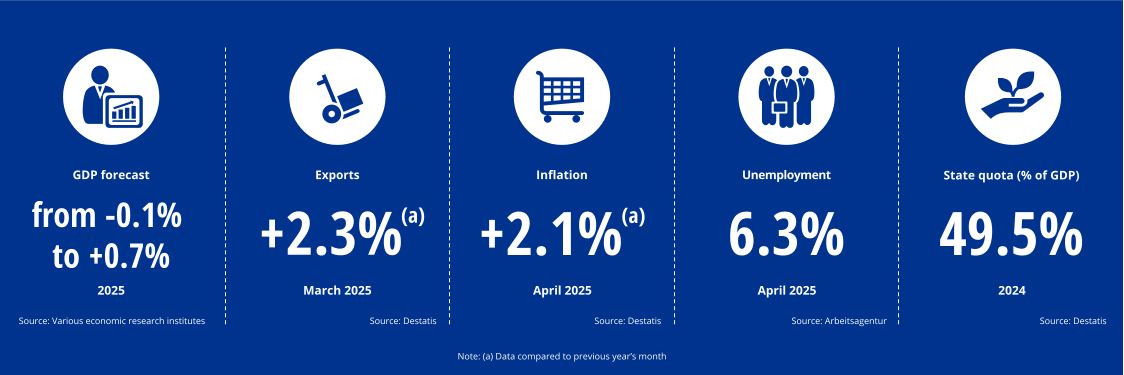With a gross domestic product of 4,305 billion euros in 2024, Germany is the third largest economy in the world after the United States and China and just ahead of Japan, making it the largest economy in Europe. In particular, exports of motor vehicles and vehicle parts as well as chemical products have made Germany the third largest export nation in the world to date. At 70%, the service sector accounts for the largest share of the country's gross domestic product (GDP).
In addition, Germany is a top destination for investors, attracting an ever increasing number of companies to make greenfield investment there. As the largest economy in Europe, Germany entices its investors with its central-european location, but simultaneously puts them off with the current deterioration of Germany's situation as an economic destination.

Data retrieved: 8 May 2025

Federal government sees no growth in 2025 either
The outgoing German government has once again lowered its economic forecast. It now expects gross domestic product (GDP) to stagnate in 2025. In January, the government was still forecasting growth of 0.3%. For the first time in the history of the Federal Republic of Germany, the German economy is therefore not expected to grow for three years in a row
The main reasons for this are the tariffs announced by US President Donald Trump, some of which have been temporarily suspended, and the high level of global economic uncertainty. As a result, there has been turbulence on the international financial markets and a deterioration in global growth prospects. This is affecting the German economy, which is strong in exports and is already suffering from weak foreign demand.
The government does not expect a noticeable upturn in the coming year either. It anticipates GDP growth of +1.0%. Although the new federal government's fiscal policy decisions will provide positive impetus, they will only make a noticeable contribution to growth in the coming years.
By contrast, business sentiment in Germany has improved slightly. The ifo Business Climate Index rose to 86.9 points in April 2025, up from 86.7 points in March. Companies assessed their current situation more positively, but expectations clouded over. However, uncertainty among companies has increased and the German economy is bracing itself for turbulence.
The government spending ratio, which indicates the government's influence on an economy, is calculated as total government spending as a percentage of GDP. According to the International Monetary Fund (IMF), this amounted to 49.5% in Germany in 2024 and was therefore above the G7 average of 46.1% and the government share of other large economies such as the UK (44.0%), the USA (37.6%) and China (32.9%).
According to the OECD, the share of tax and social security contributions in total labor costs for average earners in Germany in 2024 was 47.9% for singles without children. This puts Germany in second worst place among the 38 member states of the OECD after Belgium and well above the OECD average of 34.9%, which significantly reduces Germany's attractiveness as an investment location. The rate is also significantly lower in countries outside the EU, such as the UK (29.4%) or the USA (30.1%).
Our Business Destination Germany 2024 study provides a current assessment of Germany as a business location by international investors. 350 CFOs from the largest German subsidiaries of international corporations from the most important investor countries were surveyed as part of the study to find out how they rate Germany as a business location. As this is the fourth time the study has been published every two years, it also enables trend statements to be made.
The KPMG Global Navigator also provides insights into global growth prospects, opportunities and challenges.
Our CEO-Outlook 2024/25, for which 1,325 CEOs of large companies around the world were surveyed, including 125 CEOs in Germany, also provides assessments of the economic situation, generative AI, ESG and other current topics.
The current forecasts of German economic research institutes and government organizations on the development of GDP in Germany recently fluctuate between -0.1% and +0.7% for the calendar year 2025:

Data retrieved: 8 May 2025
While more and more institutes are only expecting the German economy to stagnate this year, the RWI is the first institute to even expect the economy to remain in recession. In particular, the additional tariffs of 20% on all products from the EU announced on "Liberation Day" and the tariffs of 25% on cars, car parts, steel and aluminum will hit the export-oriented German economy.
However, the Kiel Institute for the World Economy (IfW) assumes (as of April 30, 2025) that the costs for the EU and its member states will be manageable. The reason for this is that the US tariff regime applies to all countries worldwide, meaning that the EU and Germany will not experience any particular disadvantages. The effects will be most noticeable in Germany due to the country's strongly foreign-oriented economy. Economic output is likely to fall by an additional 0.2% over the year as a result of this effect.

German exports increase in March 2025
German exports grew again in March 2025. Exports rose by +1.1% compared to the previous month and +2.3% compared to the same month last year to 133.2 billion euros.
Most German exports went to the United States in March 2025 with a value of 14.6 billion euros. Adjusted for calendar and seasonal effects, +2.4% more goods were exported there than in February 2025. Most imports in March 2025 came from the People's Republic of China. Goods worth €14.7 billion were imported from there, adjusted for calendar and seasonal effects. This was +9.6% more than in the previous month.
According to the Kiel Institute's calculations, German exports are also likely to fall by 0.2% over the course of the year, in line with economic output.
Real (price-adjusted) incoming orders in the manufacturing sector rose by 3.6% in March 2025 compared to February 2025, adjusted for seasonal and calendar effects. In a less volatile three-month comparison, new orders in Q1 2025 were 2.3% lower than in Q4 2024.

Inflation rate continues to fall in April 2025
Falling energy prices have pushed the inflation rate in Germany to its lowest level in six months. Prices for goods and services rose by just 2.1% in April 2025 compared to the same month last year. This is the lowest figure since October 2024. In March 2025, consumer prices had risen slightly more, by 2.2%.
Energy became significantly cheaper: it cost 5.4% less in April 2025 than a year earlier. One reason for this is falling global market prices for crude oil. This is due to the trade war started by US President Donald Trump, which economists believe is weighing on the global economy and is therefore likely to dampen demand for oil. Food, on the other hand, remained the price driver. These became 2.8% more expensive. Services also cost 3.9% more than in the same month last year. Core inflation rose to 2.9%.
The number of companies planning price increases in the coming months fell slightly in March 2025: The ifo Institute's barometer for price expectations fell slightly to 18.7 points in March 2025 (February 2025: 19.3 points).* While retail and industry are less likely to plan to raise prices, service providers see more scope for rising prices.
*The points indicate the percentage of companies that intend to raise their prices on balance (percentage of companies that intend to lower their prices minus the percentage of companies that intend to raise their prices). If all the companies surveyed intended to increase their prices, the balance would be +100 points. If they all wanted to lower their prices, the balance would be -100.
Current forecasts by German economic research institutes and government organizations on the development of the inflation rate in Germany indicate that the value will remain at around the current level. For the calendar year 2025, the projections fluctuate between +2.0% and +2.4%:

Data retrieved: 8 May 2025
The Kiel Institute assumes that prices are likely to fall by 0.3% over the course of the year, as products destined for the global market are now being offered domestically. The fear of a "glut" of Chinese goods, which were previously exported from China to the USA and now represent additional competition for German and European exporters on the global market, is unfounded according to the simulation calculations.

Number of unemployed falls only slightly in April 2025
Thanks to a slight spring upturn, the number of unemployed people in Germany fell by 36,000 to 2.932 million in April 2025 compared to the previous month. This is 182,000 more than in April 2024. Compared to March, the unemployment rate fell by 0.1 points to 6.3%. Compared to the same month last year, the rate increased by 0.3 percentage points.
The economic weakness is leaving ever deeper marks on the labor market. Although overall unemployment and underemployment changed little on a seasonally adjusted basis in April, there were significant increases in the cyclical unemployment insurance. Although the risk of becoming unemployed due to loss of employment is comparatively low, it is steadily increasing; and the chances of ending unemployment by taking up employment are at a historically low level. Employers are still reluctant to register new jobs. Although seasonally adjusted, employment subject to social insurance contributions has grown only slightly. Employment subject to social insurance contributions is increasing in the government-related service sectors, while significant declines are being recorded in the manufacturing industry in particular.
State quota rises to almost 50% in 2024
According to the Federal Statistical Office, higher government spending led to an increase in the German state quota to 49.5% in 2024. This represents an increase of 1.1 percentage points compared to the previous year (2023: 48.4%).
The increase in the expenditure ratio last year was primarily due to a significant rise in monetary social benefits. For example, for pensions, care or citizens' benefits, as well as higher social benefits in kind, such as for hospital treatment or care.
Video talks on Germany as a business location (KPMG Zukunftsgipfel 2024 - in English)
AI driving data center’s growth and chip production in Germany
Amazon’s regulatory agenda
Innovations in the energy sector: BP and Statkraft
More interesting content for you
Your contacts
Stay up to date with what matters to you
Gain access to personalized content based on your interests by signing up today
Andreas Glunz
Managing Partner International Business
KPMG AG Wirtschaftsprüfungsgesellschaft
Joachim von Prittwitz
Markets, International Business
KPMG AG Wirtschaftsprüfungsgesellschaft
Connect with us
- Find office locations kpmg.findOfficeLocations
- kpmg.emailUs
- Social media @ KPMG kpmg.socialMedia






